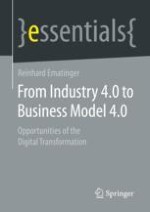2021 | Buch
Über dieses Buch
In this essential you will learn how to use the changed rules of the game of Industry 4.0 and discover patterns for new business models. Reinhard Ematinger shows you how to describe your current business model in a structured way, sketch and test new business models and define the benefits for existing and new customers. Real and current examples accompany you through this book and questions support you in the transfer to application in your organization.
This Springer essential is a translation of the original German 1st edition essentials, Von der Industrie 4.0 zum Geschäftsmodell 4.0 by Reinhard Ematinger, published by Springer Fachmedien Wiesbaden GmbH, part of Springer Nature in 2018.The translation was done with the help of artificial intelligence (machine translation by the service DeepL.com). A subsequent human revision was done primarily in terms of content, so that the book will read stylistically differently from a conventional translation. Springer Nature works continuously to further the development of tools for the production of books and on the related technologies to support the authors.
Anzeige
